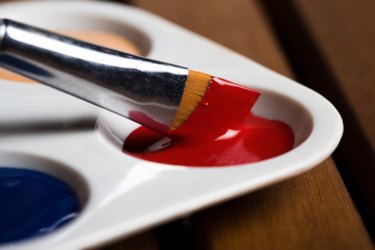
Artists must keep in mind the properties of foam core board if they wish to paint on it. Foam core has a polystyrene, pillow-like center that will eventually breakdown from ultraviolet light. It can be damaged by dents or punctures, and the paper facing cannot withstand moisture. Solvents and lacquers will also erode the polystyrene centers. Knowing these things can be a real game-changer when it comes to choosing the right paint and ensuring the longevity of your work.
Spray
Video of the Day
Spray paint is contained inside an aerosol can and sprays a mist of paint that creates a more uniform application than brushes. Some of the solvents in spray paint may damage the inner polystyrene in the foam board, so it should only be used on the paper exterior. Foam core boards are sensitive to moisture, and spray paint has less moisture than many other paints. It also dries faster than oil paints applied by brush.
Video of the Day
Acrylic
Acrylic paint is ideal on foam core because you do not need to use solvents like with oil paints. Acrylic it fast-drying, durable and adheres to most surfaces. It also has an even sheen and does not need a base coat.
Oil
Oil paints are a mixture of dry pigments and an oil like linseed. It dries slowly and may slide off the foam core board's slick paper surface. Therefore, the board should be placed flat for oil painting. In addition, shellacs and solvents will damage the polystyrene foam sandwiched between the paper exterior, so artists who use oil paints should apply varnish or paint thinner sparingly, if at all.
Gouache
Watercolor paints should not be used on foam core because the paper will be damaged by the moisture; however, gouache can give similar results of watercolor paints without the excess wetness. Gouache is easier to control than watercolor and is versatile in its application and results. Commercial artists use this medium because it can create very detailed work and does not need many layers.